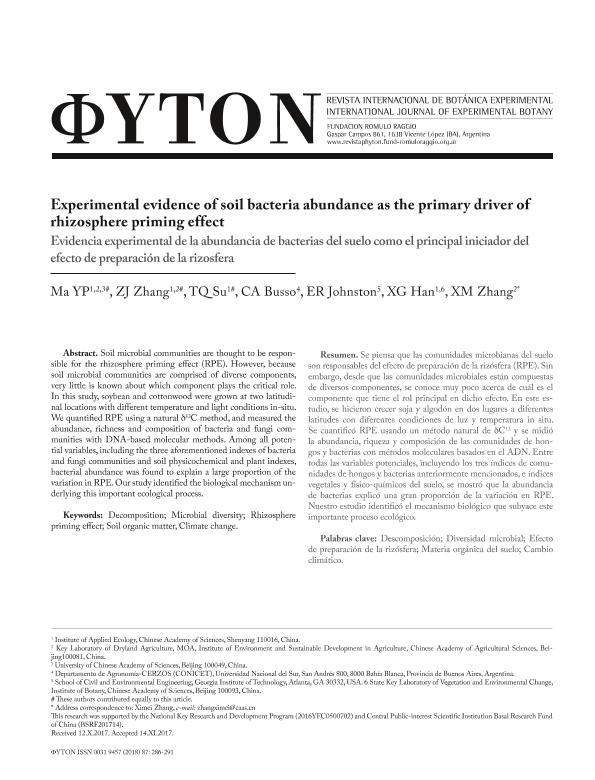Mostrar el registro sencillo del ítem
dc.contributor.author
Ma, Y.P.
dc.contributor.author
Zhang, Z.J.
dc.contributor.author
Su, T.Q.
dc.contributor.author
Busso, Carlos Alberto

dc.contributor.author
Johnston, E.R.
dc.contributor.author
Han, X.G.
dc.contributor.author
Zhang, X.M.
dc.date.available
2019-10-29T15:42:02Z
dc.date.issued
2018-12
dc.identifier.citation
Ma, Y.P.; Zhang, Z.J.; Su, T.Q.; Busso, Carlos Alberto; Johnston, E.R.; et al.; Experimental evidence of soil bacteria abundance as the primary driver of rhizosphere priming effect; Fundación Rómulo Raggio; Phyton; 87; 12-2018; 286-291
dc.identifier.issn
0031-9457
dc.identifier.uri
http://hdl.handle.net/11336/87538
dc.description.abstract
Se piensa que las comunidades microbianas del suelo son responsables del efecto de preparación de la rizósfera (RPE). Sin embargo, desde que las comunidades microbiales están compuestas de diversos componentes, se conoce muy poco acerca de cuál es el componente que tiene el rol principal en dicho efecto. En este estudio, se hicieron crecer soja y algodón en dos lugares a diferentes latitudes con diferentes condiciones de luz y temperatura in situ. Se cuantificó RPE usando un método natural de δC13 y se midió la abundancia, riqueza y composición de las comunidades de hongos y bacterias con métodos moleculares basados en el ADN. Entre todas las variables potenciales, incluyendo los tres índices de comunidades de hongos y bacterias anteriormente mencionados, e índices vegetales y físico-químicos del suelo, se mostró que la abundancia de bacterias explicó una gran proporción de la variación en RPE. Nuestro estudio identificó el mecanismo biológico que subyace este importante proceso ecológico.
dc.description.abstract
Soil microbial communities are thougth to be responsible for the rhizosphere priming effect (RPE). However, because soil microbial communities are comprised of diverse components, very little is known about which component plays the critical role. Here, soybean and cottonwood were grown at two latitudinal locations with different temperature and light conditions in-situ. We quantified RPE using a natural 13C method, and measured the abundance, richness and composition of bacteria and fungi communities with DNA-based molecular methods. Among all potential variables, including the three aforementioned indexes of bacteria and fungi communities and soil physiochemical and plant indexes, bacterial abundance was found to explain a large proportion of variation in RPE. Our study identified the biological mechanism underlying this important ecological process.
dc.format
application/pdf
dc.language.iso
eng
dc.publisher
Fundación Rómulo Raggio

dc.rights
info:eu-repo/semantics/openAccess
dc.rights.uri
https://creativecommons.org/licenses/by-nc-sa/2.5/ar/
dc.subject
DESCOMPOSICIÓN
dc.subject
DIVERSIDAD MICROBIAL
dc.subject
EFECTO DE PREPARACION DE LA RIZOSFERA
dc.subject
MATERIA ORGÁNICA DEL SUELO
dc.subject
CAMBIO CLIMÁTICO
dc.subject.classification
Ecología

dc.subject.classification
Ciencias Biológicas

dc.subject.classification
CIENCIAS NATURALES Y EXACTAS

dc.title
Experimental evidence of soil bacteria abundance as the primary driver of rhizosphere priming effect
dc.title
Evidencia experimental de la abundancia de bacterias del suelo como el principal iniciador del efecto de preparación de la rizosfera
dc.type
info:eu-repo/semantics/article
dc.type
info:ar-repo/semantics/artículo
dc.type
info:eu-repo/semantics/publishedVersion
dc.date.updated
2019-10-22T18:03:32Z
dc.identifier.eissn
1851-5657
dc.journal.volume
87
dc.journal.pagination
286-291
dc.journal.pais
Argentina

dc.journal.ciudad
Buenos Aires
dc.description.fil
Fil: Ma, Y.P.. Chinese Academy of Sciences. Institute of Applied Ecology; China. Chinese Academy of Agricultural Sciences. Institute of Environment and Sustainable Development in Agriculture. Key Laboratory of Dryland Agriculture;; China. University of Chinese Academy of Science; China
dc.description.fil
Fil: Zhang, Z.J.. Chinese Academy of Sciences. Institute of Applied Ecology; China. Chinese Academy of Agricultural Sciences. Institute of Environment and Sustainable Development in Agriculture. Key Laboratory of Dryland Agriculture;; China
dc.description.fil
Fil: Su, T.Q.. Chinese Academy of Sciences. Institute of Applied Ecology; China
dc.description.fil
Fil: Busso, Carlos Alberto. Universidad Nacional del Sur. Departamento de Agronomía; Argentina. Consejo Nacional de Investigaciones Científicas y Técnicas. Centro Científico Tecnológico Conicet - Bahía Blanca. Centro de Recursos Naturales Renovables de la Zona Semiárida. Universidad Nacional del Sur. Centro de Recursos Naturales Renovables de la Zona Semiárida; Argentina
dc.description.fil
Fil: Johnston, E.R.. Georgia Institute of Technology. School of Civil and Environmental Engineering; Estados Unidos
dc.description.fil
Fil: Han, X.G.. Chinese Academy of Sciences. Institute of Applied Ecology; China. Chinese Academy of Sciences. Institute of Botany. State Key Laboratory of Vegetation and Environmental Change; China
dc.description.fil
Fil: Zhang, X.M.. Chinese Academy of Agricultural Sciences. Institute of Environment and Sustainable Development in Agriculture. Key Laboratory of Dryland Agriculture;; China
dc.journal.title
Phyton

dc.relation.alternativeid
info:eu-repo/semantics/altIdentifier/url/http://www.revistaphyton.fund-romuloraggio.org.ar/vol87.html
Archivos asociados
